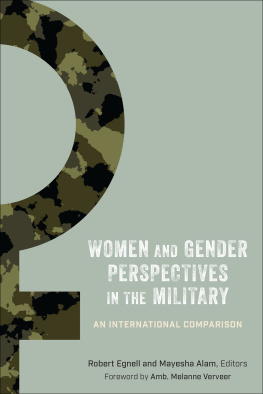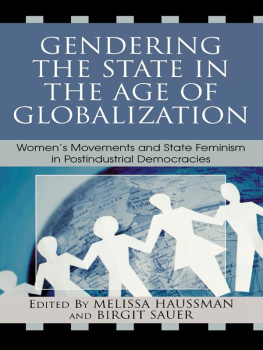THE INTERPLAY BETWEEN GENDER, MARKETS AND THE STATE IN SWEDEN, GERMANY AND THE UNITED STATES
To the memory of my grandmother, Lilja Torfadttir
The Interplay Between Gender, Markets and the State in Sweden, Germany and the United States
Lilja Msesdttir
First published 2001 by Ashgate Publishing
Reissued 2018 by Routledge
2 Park Square, Milton Park, Abingdon, Oxon OX14 4RN
711 Third Avenue, New York, NY 10017, USA
Routledge is an imprint of the Taylor & Francis Group, an informa business
Copyright Lilja Msesdttir 2001
All rights reserved. No part of this book may be reprinted or reproduced or utilised in any form or by any electronic, mechanical, or other means, now known or hereafter invented, including photocopying and recording, or in any information storage or retrieval system, without permission in writing from the publishers.
Notice:
Product or corporate names may be trademarks or registered trademarks, and are used only for identification and explanation without intent to infringe.
Publisher's Note
The publisher has gone to great lengths to ensure the quality of this reprint but points out that some imperfections in the original copies may be apparent.
Disclaimer
The publisher has made every effort to trace copyright holders and welcomes correspondence from those they have been unable to contact.
A Library of Congress record exists under LC control number: 2001088802
ISBN 13: 978-1-138-72357-3 (hbk)
ISBN 13: 978-1-315-19294-9 (ebk)
This work could not have been completed without the encouragement and assistance of many people and it is a great pleasure to have now the opportunity to thank them.
I would like to start by thanking Ivar Jonsson for our constructive discussions about my work. I am also in debt to Professor Jill Rubery, for encouraging me to break out of disciplinary cleavages and for her valuable collaboration throughout the writing of this book. Moreover, I would like to thank Professor Rosemary Crompton and Jordan Goodman for constructive comments on this work.
During the couse of writing this book, I have benefited from comments on earlier drafts made by anonymous readers at the British Journal of Sociology and Acta Sociologica as well as by Collete Fagan, Damian Grimshaw, Susanne Schunter-Kleemann, Jordan Goodman, Guon B. Eydal, Tmas Bjarnason, Mary Daly, Birte Siim, Jackie O'Reilly and Dominique Anox. I would also like to mention people who have been very helpful at different stages of this work. Among these are Ian Gough, Ann S. Orloff, Traute Meyer, Bengt Furker, Ruth Emerik, Diana Perrons, Anne Kovalainen, Pertti Koistinen, Ilona Ostner, Katarina Katz and Donald Storrie. I would also like to thank Elsabet Andrsdttir for her valuable assistance with formatting the final manuscript.
As this book is about three countries and has been written in four countries, I have had to rely on the generosity of many institutions. I would especially like to mention Reykjavk University, University of Manchester Institute of Science and Technology (UMIST), the University of Greenland, the Centre for European Labour Market Studies, University of Gothenburg, Sweden, Wissenschaftszentrum Berlin (WZB), Germany, the Institute of Social Policy at the Georg-August-University, Germany, FREIA Feminist Research Centre in Aalborg, Denmark, Harvard University, Boston, the United States and Institute for Women's Policy Research, Washington, the United States. Finally, I would like to acknowledge that my past experiences as an economist for the Icelandic Federation of Labour, AS, and as a political activist within and outside the Women's List (Kvennalistinn) in Iceland have been a valuable source of ideas throughout the writing of this work.
The development of gender relations during the post-war period in Sweden, Germany and the United States forms the core of this work. Gender relations refer to the hierarchical relations between men and women in which women are subordinated to men. The hierarchical relations are based on economic, political, social and biological differentiation between men and women. We compare forms/patterns of gender relations across the three countries and their development through time. Our analytical focus is primarily on how actors, cultural norms and institutional arrangements interrelate and affect the relative position of men and women creating certain patterns/forms of gender relations that vary across countries and change through time. Hence, we are not concerned with explaining the origin of women's subordination but the particular form it takes across space and time. Comparing patterns of gender relations across countries with different histories of social relations and institutional settings reveals the importance of social structures (actors and institutions) in shaping common trends in the industrialised societies. An integration of women into paid work and politics has, for example, occurred in Sweden, Germany and the United States. However, the speed at which this common trend has taken place and its implications in terms of pay and segregation differs across the three countries. Sweden was, for example, among the first to establish the dual breadwinner model while Germany is only slowly moving away from the male breadwinner model. The United States is positioned between the other two countries.
Our main assertion as concerns the development of gender relations in Sweden, Germany and the United States during the post-war period is that incremental changes have accumulated into a shift from one form/pattern of gender relations to another or from the male breadwinner model to the dual breadwinner model. However, the shift has involved overlapping developments with dual, breadwinner and one-headed models existing at the same time and multi-linear development across countries. Hence, different models or patterns of gender relations exist in each country but it is possible to identify one dominant model by examining how gender relations are regulated through norms and institutional arrangements. These norms and institutional settings constitute a mode of regulation that is influenced by political struggles and compromises. A mode of regulation adjusts the behaviour of men and women to certain pattern of gender relation. Moreover, each country adopts its one variant of the male breadwinner and/or the dual breadwinner models. We term the Swedish variant of the dual breadwinner model as the egalitarian regime of gender relations and the modified male breadwinner model in Germany is captured by the ecclesiastical regime of gender relations. The liberal regime of gender relations in the United States is positioned between the other two regimes with male and dual breadwinner models coexisting, although the latter is becoming more dominant than the former.
Our study of the development of gender relations is comparative and historical, i.e. the same issues are examined in more than one country and the historical development of these issues is also explored. One of the main advantages of a comparative study is that it highlights the differences and the similarities of the countries being compared. Sweden, Germany and the United States are comparable as they are highly industrialised and have similar structures of representative democracy. These countries differ, however, with respect to the patterns of gender relations (the dependent variable). In this book, we argue that social blocks (independent variable) involving a stable system of relations that have challenged and become embedded into institutional arrangements are the main force creating differences in the patterns of gender relations across the three countries. Our choice of Sweden, Germany and the United States is based on the belief that differences are more revealing about the forces shaping the patterns/forms of gender relations than similarities. Our historical approach rests on the assumption that actors can only change social structures through existing relations and institutional arrangements. Hence, present social structures can only be understood in view of past struggles and institutional compromises. A historical approach in comparative studies is essential as variation across space is the outcome of previous similarities and dissimilarities underlying the variation (see yen 1992; Kalberg 1994).









